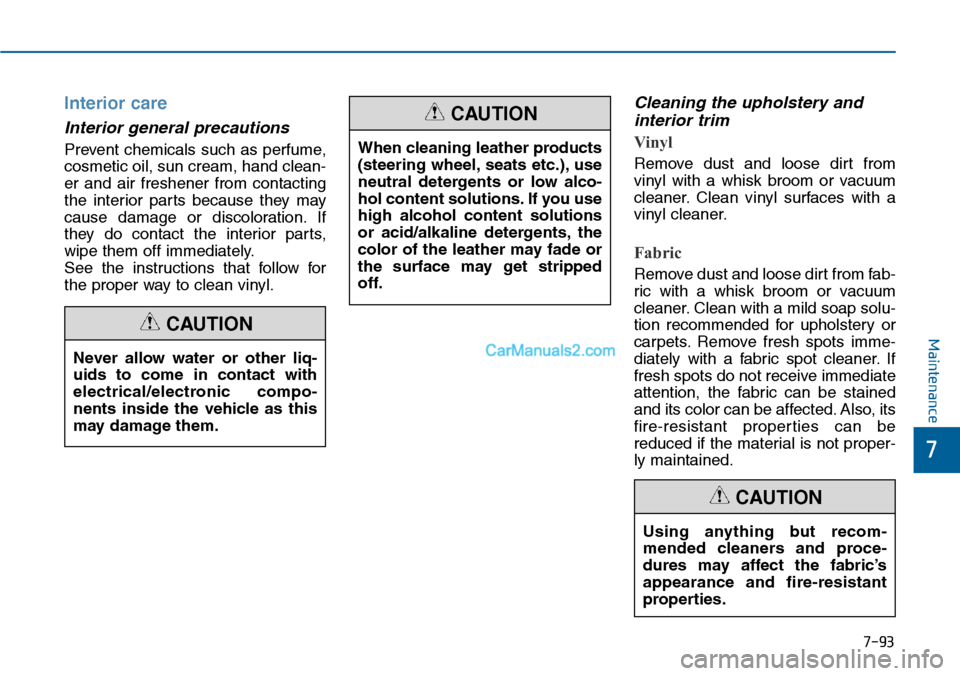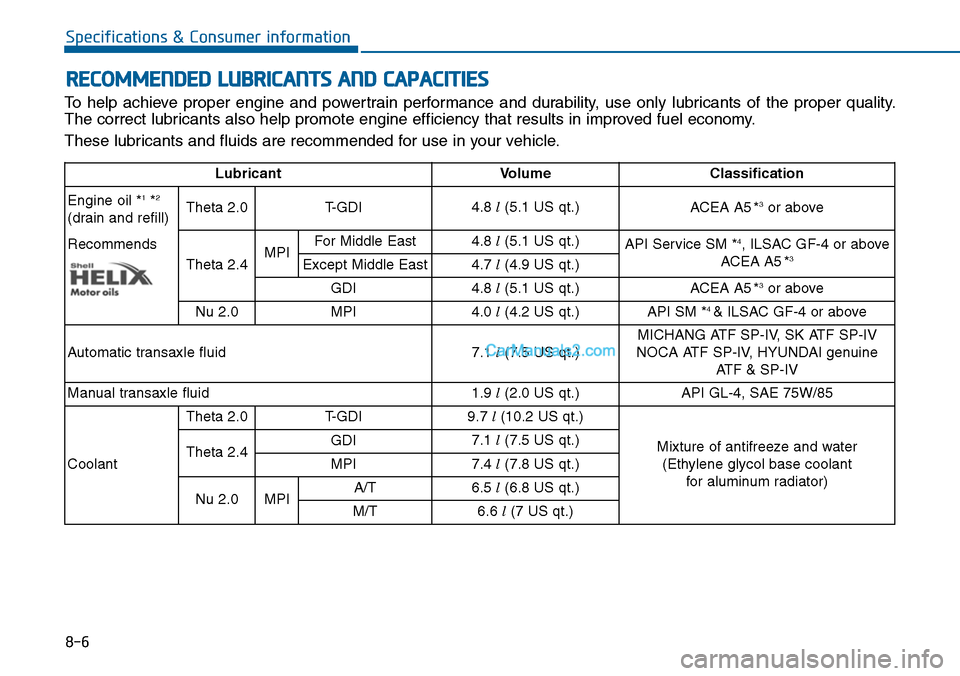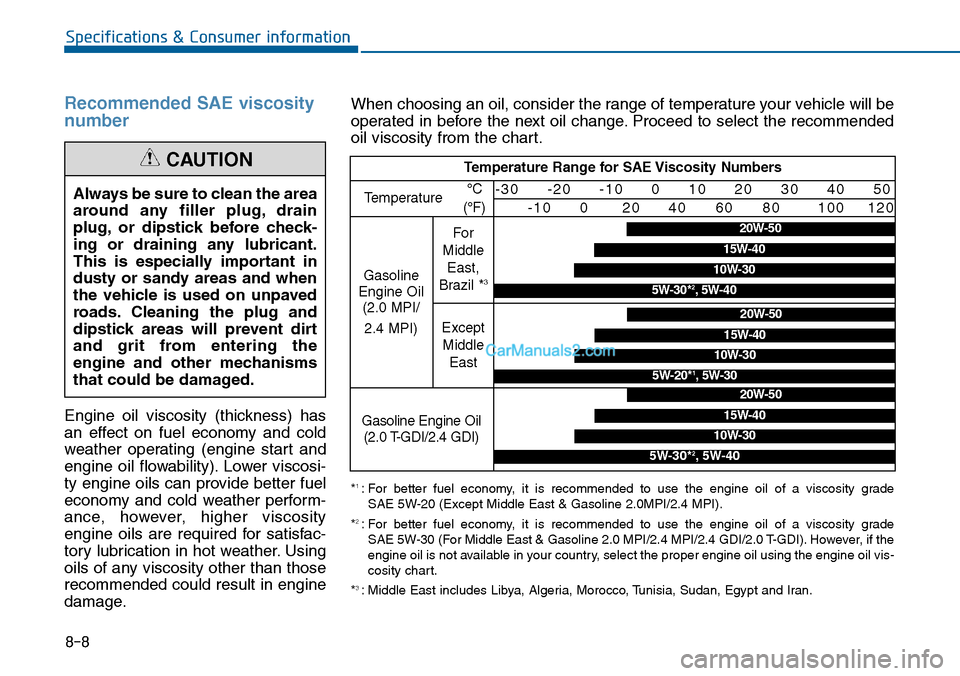Page 650 of 665

7-93
7
Maintenance
Interior care
Interior general precautions
Prevent chemicals such as perfume,
cosmetic oil, sun cream, hand clean-
er and air freshener from contacting
the interior parts because they may
cause damage or discoloration. If
they do contact the interior parts,
wipe them off immediately.
See the instructions that follow for
the proper way to clean vinyl.
Cleaning the upholstery and
interior trim
Vinyl
Remove dust and loose dirt from
vinyl with a whisk broom or vacuum
cleaner. Clean vinyl surfaces with a
vinyl cleaner.
Fabric
Remove dust and loose dirt from fab-
ric with a whisk broom or vacuum
cleaner. Clean with a mild soap solu-
tion recommended for upholstery or
carpets. Remove fresh spots imme-
diately with a fabric spot cleaner. If
fresh spots do not receive immediate
attention, the fabric can be stained
and its color can be affected. Also, its
fire-resistant properties can be
reduced if the material is not proper-
ly maintained.
Never allow water or other liq-
uids to come in contact with
electrical/electronic compo-
nents inside the vehicle as this
may damage them.
CAUTION
When cleaning leather products
(steering wheel, seats etc.), use
neutral detergents or low alco-
hol content solutions. If you use
high alcohol content solutions
or acid/alkaline detergents, the
color of the leather may fade or
the surface may get stripped
off.
CAUTION
Using anything but recom-
mended cleaners and proce-
dures may affect the fabric’s
appearance and fire-resistant
properties.
CAUTION
Page 651 of 665
7-94
Maintenance
Cleaning the lap/shoulder belt
webbing
Clean the belt webbing with any mild
soap solution recommended for
cleaning upholstery or carpet. Follow
the instructions provided with the
soap. Do not bleach or re-dye the
webbing because this may weaken it.
Cleaning the interior window
glass
If the interior glass surfaces of the
vehicle become fogged (that is, cov-
ered with an oily, greasy or waxy
film), they should be cleaned with
glass cleaner. Follow the directions
on the glass cleaner container.
Do not scrape or scratch the
inside of the rear window. This
may result in damage to the rear
window defroster grid.
CAUTION
Page 661 of 665

8-6
Specifications & Consumer information
RECOMMENDED LUBRICANTS AND CAPACITIES
To help achieve proper engine and powertrain performance and durability, use only lubricants of the proper quality.
The correct lubricants also help promote engine efficiency that results in improved fuel economy.
These lubricants and fluids are recommended for use in your vehicle.
LubricantVo l u m e C l a s s i f i c a t i o n
Engine oil *1*2
(drain and refill)
Recommends
Theta 2.0 T-GDI4.8l(5.1 US qt.)ACEA A5 *3or above
Theta 2.4MPIFor Middle East4.8l(5.1 US qt.)API Service SM *4, ILSAC GF-4 or above
ACEA A5 *3Except Middle East4.7l(4.9 US qt.)
GDI4.8l(5.1 US qt.)ACEA A5 *3or above
Nu 2.0 MPI4.0l(4.2 US qt.)API SM *4 & ILSAC GF-4 or above
Automatic transaxle fluid7.1l(7.5 US qt.)
MICHANG ATF SP-IV, SK ATF SP-IV
NOCA ATF SP-IV, HYUNDAI genuine
AT F & S P - I V
Manual transaxle fluid1.9l(2.0 US qt.)API GL-4, SAE 75W/85
Coolant
Theta 2.0T- G D I9.7 l(10.2 US qt.)
Mixture of antifreeze and water
(Ethylene glycol base coolant
for aluminum radiator)
Theta 2.4GDI7.1 l(7.5 US qt.)
MPI7.4 l(7.8 US qt.)
Nu 2.0 MPIA/T6.5 l(6.8 US qt.)
M/T6.6 l(7 US qt.)
Page 662 of 665
8-7
8
Specifications & Consumer information*1:Refer to the recommended SAE viscosity numbers on the next page.
*2:Engine oils labeled Energy Conserving Oil are now available.Along with other additional benefits, they contribute to fuel economy by reducingthe amount of fuel necessary to overcome engine friction. Often, these improvements are difficult to measure in everyday driving, but in a year’stime, they can offer significant cost and energy savings.
*3:If the ACEA A5 engine oil is not available in your country, you are able to use ILSAC GF-4 (or above) or API SM (or above).
*4:If the API service SM engine oil is not available in your country, you are able to use API service SL.
Lubricant Volume Classification
Brake/clutch fluid0.7~0.8 l(0.74~0.85 US qt.)FMVSS116 DOT-3 or DOT-4
Fuel70 l(18.49 US gal.)Refer to “Fuel Requirements” in the Foreword chapter.
Page 663 of 665

8-8
Specifications & Consumer information
Recommended SAE viscosity
number
Engine oil viscosity (thickness) has
an effect on fuel economy and cold
weather operating (engine start and
engine oil flowability). Lower viscosi-
ty engine oils can provide better fuel
economy and cold weather perform-
ance, however, higher viscosity
engine oils are required for satisfac-
tory lubrication in hot weather. Using
oils of any viscosity other than those
recommended could result in engine
damage.
Always be sure to clean the area
around any filler plug, drain
plug, or dipstick before check-
ing or draining any lubricant.
This is especially important in
dusty or sandy areas and when
the vehicle is used on unpaved
roads. Cleaning the plug and
dipstick areas will prevent dirt
and grit from entering the
engine and other mechanisms
that could be damaged.
CAUTIONTemperature Range for SAE Viscosity Numbers
Temperature
Gasoline Engine Oil(2.0 MPI/
2.4 MPI)
°C
(°F)
-30 -20 -10 0 10 20 30 40 50
-10 0 20 40 60 80 100 120
*1 :For better fuel economy, it is recommended to use the engine oil of a viscosity grade SAE 5W-20 (Except Middle East & Gasoline 2.0MPI/2.4 MPI).
*2 :For better fuel economy, it is recommended to use the engine oil of a viscosity grade SAE 5W-30 (For Middle East & Gasoline 2.0 MPI/2.4 MPI/2.4 GDI/2.0 T-GDI). However, if theengine oil is not available in your country, select the proper engine oil using the engine oil vis-cosity chart.
*3:Middle East includes Libya, Algeria, Morocco, Tunisia, Sudan, Egypt and Iran.
20W-50
10W-30
15W-40
5W-30*2,5W-40
Gasoline Engine Oil(2.0 T-GDI/2.4 GDI)
For
Middle
East,
Brazil *3
20W-50
10W-30
15W-40
5W-20*1,5W-30
Except
Middle
East
20W-50
10W-30
15W-40
5W-30*2,5W-40
When choosing an oil, consider the range of temperature your vehicle will be
operated in before the next oil change. Proceed to select the recommended
oil viscosity from the chart.